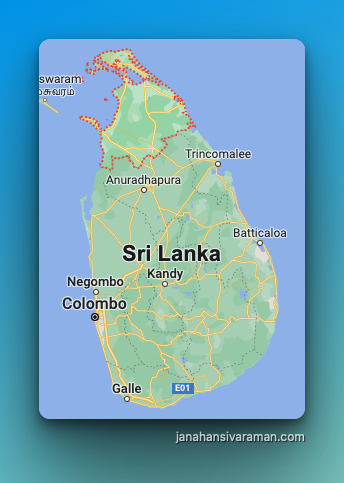How I Learned Tamil In My 30s

I learned a hyper-specific regional dialect of Tamil from the Northern Province of Sri Lanka (SL) while never having left New York City.
In fact, I’ve never even been to SL.
I used to think this was impossible, until I did it myself.
My Why
When I was 23, I watched as my grandma (Ammamma) started to forget English. This is common among older people - to forget the language they learned last. So for Ammamma, this meant she forgot English, then Singhalese, leaving only Tamil for her to communicate in.
It dawned on me that if I didn’t learn Tamil before my own mother (Amma) forgot English (30-40 years in the future), I’d never forgive myself.
It became a life goal to learn Tamil before Amma forgot English. I searched for 5 years on Google and Youtube for resources to learn SL Tamil. I even cold emailed YouTubers asking if they would teach me privately.
And nobody replied.
It made me feel like I’d never be able to learn SL Tamil.
I thought that the language would die with me. That my Amma wouldn’t be able to communicate with anyone in her later years. That she’d spend her last days unheard.
It made me feel like I’d failed my family.
Finding a Teacher
On April 9th 2020, I turned 30.
I still could not speak a full sentence of Tamil. The extent of my speech was subject-verb(S-V) sentences within the kitchen context (“எனக்கு பசிக்கிது" - “I’m hungry”, “நல்ல இருசி" - “it’s tasty”). I also found a random vocab deck for SL Tamil (that I don’t recommend), but spent hours studying.
In May 2020, I DM’ed an account on Instagram with the handle “@thetamilchannel”. Her name was Sabtha. Her accent sounded like it was from Northern Province SL. I asked if she’d be able to teach me - from London.
Her plans to go to Korea to teach English were canceled due to the pandemic.
We started the next week.
In Tamil, there is a formal flavor (newscasters, radio, newspapers) and a colloquial flavor (what people speak to each other).
I chose to focus on formal Tamil with Sabtha. I figured it would be the easiest to find material for it on the internet - whether that’s grammar or vocabulary or media.
Her years of experience teaching folks Tamil as a second (or third in my case) language helped me overcome the grammar and sentence structure gaps I had.
Within the first 8 weeks, I spent 6 hours a week on voice notes and writing and started making complete sentences. I finally overcame communicating in broken Tamil. It lit a fire in my soul.
I summarized the learnings here.
We had class every week for 18 months - 100% in Tamil.
Sabtha wrote down words I said in English or words that I looked confused that she said in Tamil. She would send me each as individual Whatsapp voice messages. The expectation was I had to respond to each message with the proper pronunciation.
She was strict on pronunciation.
We learned 1003 words and 100s of sentences over the 18 months we worked together.
After 1.5 years, I was finally comfortable with reading and writing, but speaking and listening (in conversation) still gave me anxiety.
During this time, I recall many times in conversation I’d ask my Amma to repeat words, only to realize they were words I knew - sometimes with only slightly different pronunciations from the formal flavor.
It was frustrating to know all the time and effort I’d put into reading and writing formal Tamil didn’t fully translate into listening and speaking colloquial Tamil.
TamilApp
By this point in August 2021, I was able to read/write formal Tamil at an intermediate level.
I was so excited to pay forward this knowledge that I spent 6 months building TamilApp.
I spent my nights and weekends on it.
It was loosely based on Rosetta Stone. Rosetta Stone is a language learning app that has been popular since the 1980s. I used it to learn Spanish when I was 24, to intermediate level.
In January 2022, with Sabtha, launched TamilApp to a set of 30 interested users. We also conducted user research surveys. During those, I found out that 95% wanted to learn colloquial Tamil; not formal Tamil.
I had spent the last 6 months creating an app that could help folks learn formal Tamil. I had built an app for 5% of people. I had gotten so lost in paying forward what I knew rather than finding out what problem other people had.
At this time I felt defeated. I had stretched myself thin for too long to create something with high risk. Even my Tamil got worse during this time because I spent so much developing the app.
Reading/Writing formal doesn’t translate to Listening/Speaking colloquial as much as I expected.
I couldn’t write my way to speaking better.
Mimic Method
During Write of Passage 8, I came across another student’s “How I learned French …” article.
In there, another student, Justin Tam, made a reference to the Mimic Method.
The promise was that you could pick up any language and speak with an accent so good; even locals would mistake you for one.
Last cohort, we had an assignment to send a cold email. I decided to send it to Idahosa Ness, the creator of the Mimic Method, to see whether he would be open to teaching me. Coincidentally, he sent an email saying he was opening up 1-on-1 slots to work with him before I could click send.
I immediately applied and was 1 of 5 students accepted. We focused on Spanish, specifically Mexican Spanish. I worked diligently through the exercises to level up my Spanish. I noticed that I was able to hear sounds that previously I was missing in fast, native speech.
I was fitting my ears to the language.
Even my pronunciation got more natural.
For the exercises, I asked Idahosa how he had chosen the audio clips that paired with the exercises. He told me they were random, and that you could do the exercises with any audio/video clips you find online. I had assumed they were chosen specifically for the breadth of sounds that a target language had.
A lightbulb went off in my head at this moment - I could simultaneously do the Mimic Method exercises with clips of Tamil from Youtube.
Since I was working so diligently with the Spanish Youtube clips, I had time to pick clips from “Hello Kekutho”, a SL Tamil language podcast, to practice the same Mimic Methods. This repetition significantly helped with coordination of my lips, tongue, and breath to produce sounds that were unfamiliar to me as an English speaker learning Tamil. I even made short form videos sharing what I had learned.
I learned some unintuitive tactics for speaking in a new language. Speaking at 60% speed, using unconjugated forms of a verb to keep rhythm of speech, and maintaining eye contact.
I was so skeptical of these tips. But when I actually used the tips, I couldn’t even recognize the voice coming out of my own mouth. The pronunciation work from weeks 1-3 gave me big awareness of my lips, tongue, and breath. It sounded like I had become someone else.
Even strangers on the internet were noticing my improvements in the first 3 weeks of doing Mimic Method exercises.
I am creating a website where you can easily practice these exercises with clips from Hello Kekutho so stay tuned!
Speaking with Family Members
After practicing Mimic Method lessons for 4 weeks (May 2022), I was finally comfortable enough to start speaking with family members (other than Amma).
We had a trip to Hilton Head, South Carolina planned. Through trial and error, I realized some family members are a better fit than others to practice with.
For me, it’s critical to understand when I make a mistake, what exactly is wrong about it, and why is the correct way to say it more correct.
Not everyone can articulate that. For me, in English, it can be difficult to say why the way I am saying is correct because it is my first language. It’s hardwired.
On this trip, I discovered that one of my aunts (Giri Mami) is an expert at Tamil. She can answer any question I have and she’ll answer it completely. She is my new Tamil teacher.
Speaking with people in real life is the only way to level up on colloquial Tamil.
It filled me with pride to be able to speak with my family members in Tamil.
Where My Tamil Is Today
2.5 years later, I can speak confidently in Tamil. My Tamil is more on the formal side than colloquial. My goal is to become even smoother in the colloquial form.
I thought I’d spend the rest of my life becoming conversational in Tamil. In reality, it only took 2 years. I’m gonna spend the rest of my life paying it forward.
As of 2 weeks ago, Amma and I changed the frequency of our Tamil conversation to 5 short calls a week instead of 1 long call.
I’m hopeful the higher frequency of exposure will result in even smoother speech and higher listening comprehension.
Both “Hello Kekutho” and “Jaffna Suthan” skew towards formal Tamil. This makes it easy to apply the grammar you learn. However, if you want to connect with people, you’re going to have to practice speaking with people.
And people speak colloquially.
What’s Next?
I want to compile everything I’ve learned so anyone who wants it can find it.
I haven’t forgotten those beta users of TamilApp.
They wanted to learn colloquial Tamil.
One beta user of TamilApp is a linguist based in the UK. He wanted to learn colloquial Tamil so he could connect better with his partner’s family. He shared with me the last publication he found, dated 1972, in a thesis presented to the University of Edinburgh titled, “The Phonology of Verbal Forms in Colloquial Ceylon Tamil”
As with many languages whose people were at war for decades, there is a noticeable lack of resources.
I focused on the formal flavor of Tamil for most of my journey. That foundation makes it easy for me to map documented formal grammar patterns to colloquial nuances I notice during conversation with Amma or strangers.
It’s now my goal to document these colloquial nuances to share. I want to become the Tamil teacher I needed years ago - but for others who want to learn SL Tamil.
I don’t want anyone to feel the pain and guilt of letting their mother tongue die with them. There is a way to learn even without being immersed.
I’ve done it.
You can do it too.



